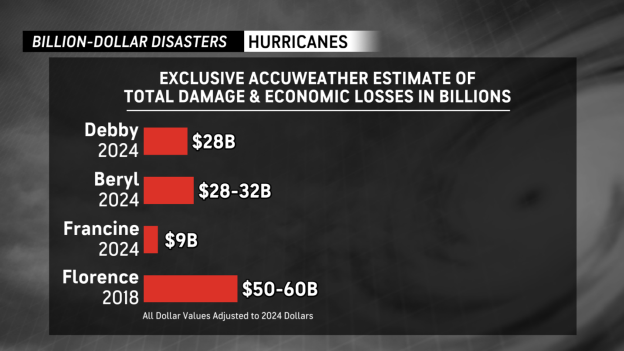Sept. 18, 2024 – AccuWeather’s preliminary estimate of the total damage and economic loss from an unnamed storm with tropical storm impacts in the United States is $7 billion. This is a preliminary estimate, as the storm effects are continuing to be felt and some areas have not yet reported complete information about damage, injuries and other impacts.
“Our team of expert meteorologists identified an area off the Carolina coast as a location for tropical development on Sept. 12, four days in advance and ahead of any other known source and began providing the information our users and customers needed to prepare for tropical storm impacts including the storm surge, flooding from rainfall and damaging winds,” said AccuWeather Chief Meteorologist Jon Porter.
The National Hurricane Center never officially named the storm that brought 1-in-1000-year extreme rainfall, severe flooding, wind gusts to nearly 80 mph and storm surge flooding to parts of North Carolina. In contrast, more than 26 hours before the government and other known sources issued their first forecast track for the storm, AccuWeather tropical storm and hurricane experts exclusively issued a forecast for the storm’s track and intensity and, importantly, rated the storm a 1 on AccuWeather’s RealImpact™ Scale for Hurricanes, the second level designation on the scale, providing the most accurate and holistic view of the storm’s dangerous impacts, enabling people to be best prepared.
Unlike the Saffir-Simpson wind scale, used by the National Hurricane Center and most other meteorologists, the AccuWeather RealImpact™ Scale for Hurricanes rates storms from less-than-one to 5 and includes not only the wind but the extent of flooding rain and storm surge as well as the overall damage and economic impact expected from the storm.
This storm comes on the heels of Hurricane Francine, which made landfall in Louisiana last week. AccuWeather experts issued an exclusive preliminary estimate of the total damage and economic loss from Francine at $9 billion, with impacts from Louisiana and Mississippi northward into the Mississippi and western Tennessee valleys. The combined impact of both storms within 2 weeks can place strain on disaster recovery resources and even cause some negative impact on the United States economy and GDP.
“From Oak Island to Seabreeze, there was a focused, intense rainband producing rates as high as 5-6 inches per hour; only about 15-20 miles in width but extending over 100 miles in length from over the Atlantic into southeast North Carolina,” said AccuWeather Chief On-Air Meteorologist Bernie Rayno. “While there was some wind damage, it was the flooding that was catastrophic from this storm. People there are saying while it wasn’t named, it was a storm they will never forget.”
AccuWeather storm chasers Tony Laubach and Aaron Jayjack, who have decades of storm-chasing experience, described this rainband as the worst they have ever experienced. The rainband was like a firehose of moisture-laden air directed right at the southeastern North Carolina coastline for hours on end.
“The storm that brought tropical storm impacts, though never officially named by the government, caused widespread flooding damage in North Carolina at the very end of the summer tourism season,” said Porter. “Homes and businesses have been damaged. Cars will be totaled. Further beach erosion is a major concern in this area if we see any additional tropical storms or hurricanes before the end of the season, as well as any coastal storms that may develop this winter.”
AccuWeather’s estimate largely accounts for damage to homes, businesses, infrastructure, facilities, roadways and vehicles as well as power outages, which results in food spoilage and interruption to medical care and reflects damage that has already occurred. For the areas impacted by flooding, water damage tends to be particularly costly to repair and may either not be covered by homeowner’s insurance policies or underinsured relative to actual damage sustained for people who do carry additional flood insurance.
The calculation is based on an analysis incorporating independent methods to evaluate all direct and indirect impacts of the storm, includes both insured and uninsured losses, is based on a variety of sources, statistics and unique techniques AccuWeather uses to estimate the damage and includes damage to property, job and wage losses, crops, infrastructure damage, interruption of the supply chain, auxiliary business losses and airport closures as well as flight delays. The estimate also accounts for the costs of evacuations, relocations, emergency management and the government expenses for preparation and cleanup operations and the long-term effects on business logistics, transportation and tourism.

To put this event into context, AccuWeather issued an exclusive preliminary estimate that Debby was responsible for $28 billion in total damage and economic loss in August. AccuWeather issued an exclusive preliminary estimate that Hurricane Beryl brought $28-32 billion in total damage and economic loss in July. In July 2023, AccuWeather issued an exclusive preliminary estimate that Hurricane Idalia caused $18-20 billion in total damage and economic loss. AccuWeather issued an exclusive preliminary estimate that Hurricane Ian caused $180-210 billion in total damage and economic loss in 2022. AccuWeather issued an exclusive preliminary estimate that Hurricane Florence, which impacted the Carolinas into Virginia with catastrophic flooding in 2018, caused $50-60 billion in total damage and economic loss.
Graphics courtesy AccuWeather


